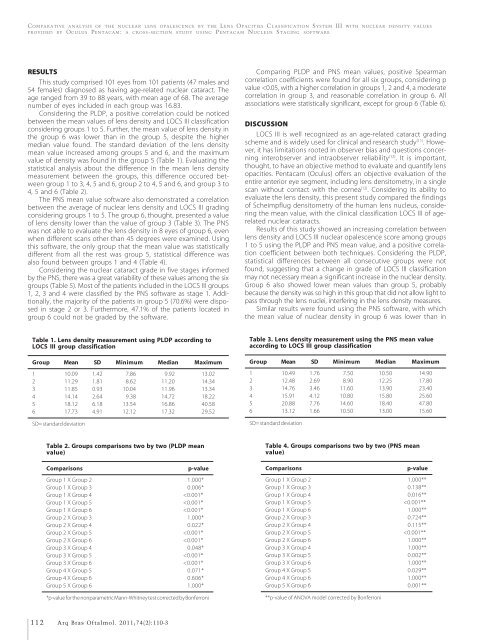a rquivos b rasileiros - Conselho Brasileiro de Oftalmologia
a rquivos b rasileiros - Conselho Brasileiro de Oftalmologia
a rquivos b rasileiros - Conselho Brasileiro de Oftalmologia
You also want an ePaper? Increase the reach of your titles
YUMPU automatically turns print PDFs into web optimized ePapers that Google loves.
COMPARATIVE ANALYSIS OF THE NUCLEAR LENS OPALESCENCE BY THE LENS OPACITIES CLASSIFICATION SYSTEM III WITH NUCLEAR DENSITY VALUES<br />
PROVIDED BY OCULUS PENTACAM: A CROSS-SECTION STUDY USING PENTACAM NUCLEUS STAGING SOFTWARE<br />
RESULTS<br />
This study comprised 101 eyes from 101 patients (47 males and<br />
54 females) diagnosed as having age-related nuclear cataract. The<br />
age ranged from 39 to 88 years, with mean age of 68. The average<br />
number of eyes inclu<strong>de</strong>d in each group was 16.83.<br />
Consi<strong>de</strong>ring the PLDP, a positive correlation could be noticed<br />
between the mean values of lens <strong>de</strong>nsity and LOCS III classification<br />
consi<strong>de</strong>ring groups 1 to 5. Further, the mean value of lens <strong>de</strong>nsity in<br />
the group 6 was lower than in the group 5, <strong>de</strong>spite the higher<br />
median value found. The standard <strong>de</strong>viation of the lens <strong>de</strong>nsity<br />
mean value increased among groups 5 and 6, and the maximum<br />
value of <strong>de</strong>nsity was found in the group 5 (Table 1). Evaluating the<br />
statistical analysis about the difference in the mean lens <strong>de</strong>nsity<br />
measurement between the groups, this difference occured between<br />
group 1 to 3, 4, 5 and 6, group 2 to 4, 5 and 6, and group 3 to<br />
4, 5 and 6 (Table 2).<br />
The PNS mean value software also <strong>de</strong>monstrated a correlation<br />
between the average of nuclear lens <strong>de</strong>nsity and LOCS III grading<br />
consi<strong>de</strong>ring groups 1 to 5. The group 6, thought, presented a value<br />
of lens <strong>de</strong>nsity lower than the value of group 3 (Table 3). The PNS<br />
was not able to evaluate the lens <strong>de</strong>nsity in 8 eyes of group 6, even<br />
when different scans other than 45 <strong>de</strong>grees were examined. Using<br />
this software, the only group that the mean value was statistically<br />
different from all the rest was group 5, statistical difference was<br />
also found between groups 1 and 4 (Table 4).<br />
Consi<strong>de</strong>ring the nuclear cataract gra<strong>de</strong> in five stages informed<br />
by the PNS, there was a great variability of these values among the six<br />
groups (Table 5). Most of the patients inclu<strong>de</strong>d in the LOCS III groups<br />
1, 2, 3 and 4 were classified by the PNS software as stage 1. Additionally,<br />
the majority of the patients in group 5 (70.6%) were disposed<br />
in stage 2 or 3. Furthermore, 47.1% of the patients located in<br />
group 6 could not be gra<strong>de</strong>d by the software.<br />
Comparing PLDP and PNS mean values, positive Spearman<br />
correlation coefficients were found for all six groups, consi<strong>de</strong>ring p<br />
value

















